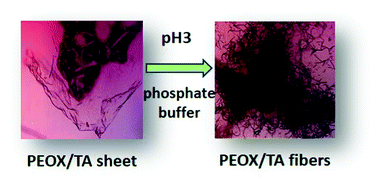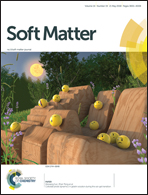Restructuring of poly(2-ethyl-2-oxazoline)/tannic acid multilayers into fibers†
Abstract
H-Bonded, pH-responsive poly(2-ethyl-2-oxazoline) (PEOX) and tannic acid (TA) multilayers were prepared by layer-by-layer deposition. Free-floating PEOX/TA multilayers were shown to restructure in a pH3 phosphate buffer solution to H-bonded, pH-responsive PEOX/TA fibers. This restructuring was also evident during the growth of multilayers thicker than 15 bilayers (BL). The growth profile of 30 BL-thick films showed a significant decrease in the film thickness from 118 nm to 85 nm between 15 BL and 20 BL, after which the growth trend was regained with some small fluctuations. This decrease was associated with the detachment of film patches from the top surface of the film. The rinse solutions consisted of fibrous aggregates, which were formed by the restructuring of the detached multilayer patches. These fibers were characterized by TGA, XPS, FTIR and SEM measurements which showed that the fibers consisted of H-bonded PEOX and TA molecules. As such, the fibers were pH-responsive and disintegrated at pH > 8.5. Scanning electron microscopy images indicated that the fibers might have been formed by the curling of planar LbL film patches and the dried fibers looked like collapsed hollow tubes on solid substrates. These results contribute to our understanding of the stability of LbL films in various chemical conditions and the ways to modify the morphology of self-assembled structures. pH-responsive fibrous aggregates are important in a variety of biomedical applications, from controlled release to sensors.



 Please wait while we load your content...
Please wait while we load your content...